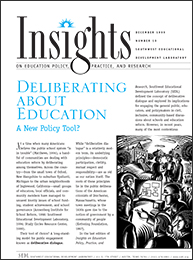What is Unique about Deliberative Dialogue?
There appears to be a mismatch between what [policymakers] gain . . . and what they want from their communications with the public.
Deliberative dialogue is a structured, face-to-face method of public interaction that takes place within small groups over an extended period of time, to ensure that all voices are heard (Guzman, 1999). When people engage in deliberative dialogues in their community, their shared purpose typically is to understand the complexities of an issue of concern and come to an informed opinion about it. To accomplish this, the dialogues are led by trained facilitators who guide participants to exchange and consider, or deliberate on, personal experiences, information, and diverse ideas on the issue. Although there are several recognized dialogue methods, each with its own structure and procedures, certain features and techniques are common across methods (see table 2).
In the end, whether or not individuals in a deliberative dialogue reach a consensus judgment, they leave the dialogue with valuable first-hand knowledge of perspectives and opinions other than their own. As one of the eight policymakers interviewed by SEDL in 1998 observed:
This approach gives [citizens] a chance… to hear other people … and they frequently find out that there is [a] side to some of these issues other than theirs. Theirs may still be the burning one to them and the most important, but they get a chance to hear another side (Mutchler & Knox, 1998, p. 10).
When contrasted with the usual ways in which state policymakers hear from the public, certain aspects of deliberative dialogue might be of particular interest to those who want more from their communications with constituents.
First, the active engagement of a group of community members in a face-to-face discussion invites the exchange of a broad range of viewpoints. This differs from the many “one-way” means of communication between policymakers and their constituents—public hearings, constituent letters, and media reports—that are prevalent in shaping public policy discussion today (National Conference of State Legislatures, 1997). In a deliberative dialogue, legislators and other state policymakers are not designated as presenters of information, nor must they be the passive recipients of facts and testimony from their constituents. They have an opportunity to simply delve into education issues alongside other individuals whose personal backgrounds and experiences may run the gamut:
… people who were concerned with the [issue], people who worked in the [environment], people who had sons, daughters, husbands, and even grandchildren (Mutchler & Knox, 1998,
p. 12).
Comparing deliberative dialogue to the more traditional means of engaging with the public also reveals its potential to yield a more textured sense of public opinion than is typically provided by polls and personal networks. The interactive nature of dialogue seems capable of allowing participants to deliberate on issues in a deeper and more sustained manner. In the words of one policymaker who shared his experiences with SEDL in 1998:
When you hear the public hash it out and you listen to them talk… you can understand and appreciate the public’s ability to weather the tradeoffs and to sustain the consequences of some action you might take (Mutchler & Knox, 1998, p. 11).
Finally, consideration of the fundamental difference between deliberation and debate suggests that deliberative dialogue also may have a significant, positive impact on the tenor of public interaction. Several policymakers noted that the facilitated discussions tended to quell partisan rancor and open participants’ minds to alternative views. “People are relieved of the pressure of having to agree with each other,” one lawmaker said. He elaborated:
It frees people from having to defend their position and enables them to do something that we hardly ever get to do… listen with the intent of understanding, not with the expectation of having to refute what’s being said (Mutchler & Knox, 1998, p. 12).
Deliberative dialogue seems to fare well in this cursory comparison with the more conventional avenues state policymakers use to gain public input and opinion about education. But why would a state policymaker decide to actually participate in deliberative dialogues with members of the public?
As with all people, policymakers must give careful consideration to the specific benefits of incorporating something new into the way they do their work and the feasibility of doing so.
In order to weigh the benefits of participating in a deliberative dialogue, a state policymaker might ask, How does this process complement my existing methods of gaining input and opinion from constituents? What does it offer that will be useful to me in making state education policy decisions?
Regarding feasibility, a state policymaker might want to be aware of any features of deliberative dialogue that could influence his or her ability or willingness to participate. Important questions here include, What do I need to know about the process in order to decide to participate? How can I be certain the experience will be worthwhile? (continues...)
1 The study circle is a nationally disseminated small-group dialogue process, refined and promoted by the Study Circles Resource Center, Pomfret, Connecticut. A National Issues Forum is a model for structured public discussion developed and promoted by the National Issues Forums Institute, Dayton, Ohio.
Features and Techniques Common Across Deliberative Dialogue Processes
| Feature | Description |
| Group member status | Democratic; dialogue participants are regarded equally around the table. |
| Dialogue environment |
|
| Interaction principles |
|
| Group norms or or "groundrules" | Vary, with typical norms including:
|
| Facilitator functions |
|
| Sources of processes reviewed include Bohm, 1990; Kettering Foundation, n.d.; Schein, 1993; Senge et al, 1994; Study Circles Resource Center, 1996. | |
Next Page: The Calling the Roll Program

